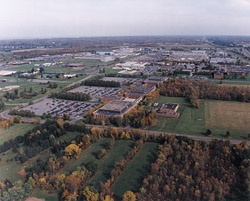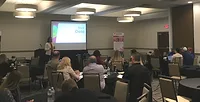Owning Up to Their Responsibility

Elevators get the marble, but roofing gets the shaft.
That still holds true for a lot of buildings, but there seems to be a change in how roofing gets done. All of these smart buildings being constructed are helping to create a new breed: the smart building owner. This era of abundance is inspiring many building owners to install a proper roofing system. At the very least, they are running out of reasons to delay replacement. They also might want to upgrade the insulation, reduce liability exposure and even start a maintenance program. Roofing contractors are now talking to building owners in a language they understand, especially when the cost benefits can be spelled out for the bean counters. “Maybe it’s the MBAs, maybe its our profession becoming more professional,” says David Susi, president of Roofing Services International in La Mesa, Calif. “[Building owners] have realized how much money they are actually spending on their roof.”Square Meal
Roofing has always been mostly retrofit and replacement as America’s aging building inventory provides plenty of residuals. While every roofing contractor salivates over the 300-square job, the bread and butter is the 20-square roof on a nondescript building with a generally indifferent owner. According to the Energy Information Administration at the Department of Energy, 95 percent of the 4.6 million commercial buildings in the United States are under 50,000 square feet, with 75 percent between 1,000 and 10,000 square feet. That leads to a lot of set-up and break-down time that has to be passed along, so more building owners are discovering the luxury of long-term solutions.When it comes to roofing, some building owners act as though they’d rather spend the money on their ex-spouse. Others have shifted into thinking of roofing as an insurance policy or even viewing it as the asset it actually is. The change may be due to the dramatic retooling of America’s industries, which are maximizing the efficiency of everything in the portfolio. After everything visible and obvious is tackled, roofing eventually comes into focus. Building owners, or at least the guy calling the shots, are more educated and know how to amortize their property improvements. But there’s still a lot of educating to do.
David Avedesian, PE, is president of PULSE Research Associates in Rockville, Md., and helps several building owners manage their assets. He also developed a preventative maintenance program for the Building Owners and Managers Association (BOMA) that allows building owners to view their roofing in a different light. Avedesian recalls the frustration in his early days of trying to channel the owner’s economic obsession into some formula they could comprehend.
“They didn’t understand what I was trying to do for them. You might as well speak Greek,” says Avedesian, who has since learned to speak to a range of building owners. “I tell them you should definitely be using an economic model for all capital investments and repairs. Let me show you how the asset value of your building will increase with this minimal investment.”
Avedesian understands that roofing will always receive a back of the house mentality, but most building owners can be convinced about protecting their investment, particularly when they aren’t flipping properties like a day trader. He sees the market going towards real estate investment trusts (REITs) when properties are held like a long-term stock. Consequently, the property’s values are measured objectively and tangible assets receive adequate maintenance, protection and upgrades that can be scheduled out over a number of years. “We’re in a mature market now,” he says. “The casual real estate owner doesn’t exist anymore. They can’t lease their buildings or rent it out if they leak when it rains. Owners are slowly becoming more knowledgeable.”
Support Columns
Once roofing moves from the liability column to the asset one, maintenance is no longer the superfluous expense it used to be. David Susi started RSI eight years ago after putting in 14 years with another contractor. He has witnessed a shift in attitude among building owners in the San Diego area and as a result his company has extensive maintenance agreements with numerous clients.“Since roof maintenance has come to the foreground ... they have taken it to the next level and incorporated it into yearly planning,” says Susi, who installs mostly BUR and modified bitumen. “That’s something you didn’t see so much even five years ago.”
The phone starts ringing around June when many companies are finalizing the upcoming fiscal year. Susi’s company is already in the loop because his crews are on the roof regularly, clearing debris and making repairs; the contract allows his crews to make up to $300 in repairs without prior authorization. The company does a lot more than clear leaves from the numerous eucalyptus trees, such as cleaning for aesthetic reasons and generating a report that is hard to ignore. “I know it doesn’t go in the circular file because we write it on our invoice,” Susi says. “We figure it’s our job to make our customers look good to the building owners.”
Another way he stays on top of the game is to send out his repair crews to strategic locations throughout the county on those relatively rare rainy days. His company has gotten up to 800 calls in a single day, and being the hero may lock up the replacement job before it ever goes out to bid. In order to get a better understanding of the building owner, Susi recently joined the local BOMA chapter as an associate. In addition to sponsoring some events and writing articles for the newsletter, building owners come up to him during association functions like people approach doctors at a cocktail party. “I think it gives you access to the mind of the property owner and it gives them access to you,” he says. “I find it interesting to go to the luncheons and hear their thoughts.”
One component that’s not even on the radar is energy efficiency, even though parts of California are reeling from recent deregulation of the energy utilities. Susi, whose own power bill shot up 250 percent, says that rebates and rollbacks are easing the shock and fostering even more complacency about energy consumption.

Knowledge is Power
One area that is getting more attention is liability. Owners who are concerned about accidents, business interruption and equipment damage have included roofing in the equation. Buildings owned by the Xerox Corporation have 9.6 million square feet, 7.2 million of which are in Monroe County, N.Y. David Nappi, manager of projects and engineering for the company’s Monroe County Real Estate Corp., says that safety is one of Xerox’s priorities. “Our safety program is aggressive enough that we record every incident, whether it’s ours or the contractors,” he explains, adding that the company has its own safety engineer. “We meet or exceed OSHA guidelines.”Companies with deep pockets have learned the merits of prevention. Nappi has some communication with other major building owners nearby, like Bausch & Lomb and Kodak, yet it’s mostly regarding safety. They’ve adopted uniform safety protocol but everyone is on their own in most other matters. “Safety is really the only factor that is across the board for all,” says Nappi. “They look at the project from a safety perspective.”
Each major property owner in the area takes its own approach. Any roofing project for Xerox in Monroe County is performed by one of three roofing contractors, all union shops that have been prequalified. Only one executes the maintenance contract that comes up for bid every three years, even though Nappi has his own crews servicing rooftop equipment. The company is putting as much mechanical equipment on the roof as possible, while installing walkways and constructing interior service corridors to minimize impact on the roof.
Nappi figures that roofing makes up 30 percent of his budget and about half of the buildings have been converted to EPDM roofing. His company typically purchases warranties for EPDM, but not BUR, including a 1,000,000-square-foot job that’s being phased in over several years. That last one was an economic decision, proving that even the biggest owners break into a sweat as they sign the check. “We try to have a set replacement strategy,” says Nappi. “We try to stretch it out as much as we can.”
So what if building owners greet roofing contractors with the same enthusiasm they reserve for dentists? Perhaps the industry needs to forget the oil change analogy and compare roofs to teeth; just one check up a year is needed. Toothaches and roof leaks don’t heal by themselves, but in order to win customers, roofing contractors will need to find their own brand of Novocaine.
Looking for a reprint of this article?
From high-res PDFs to custom plaques, order your copy today!







